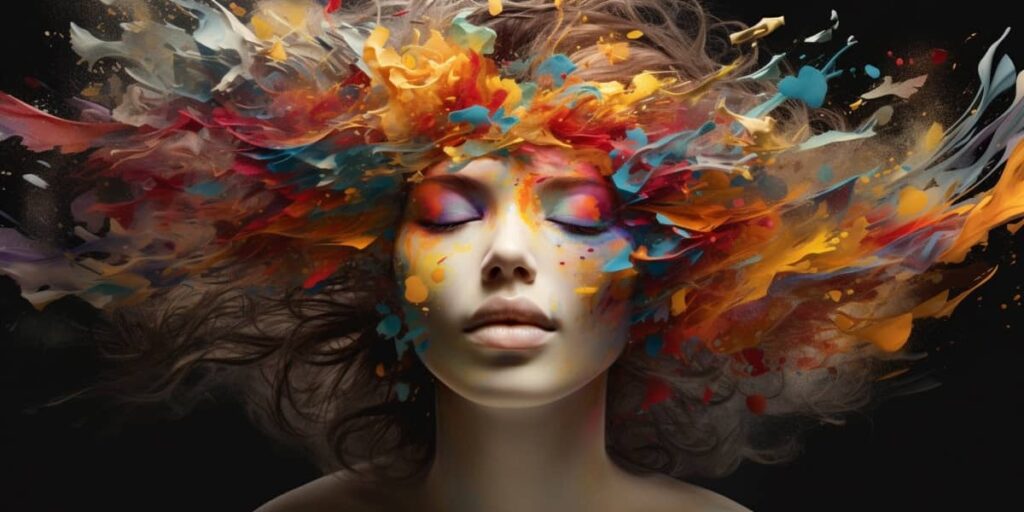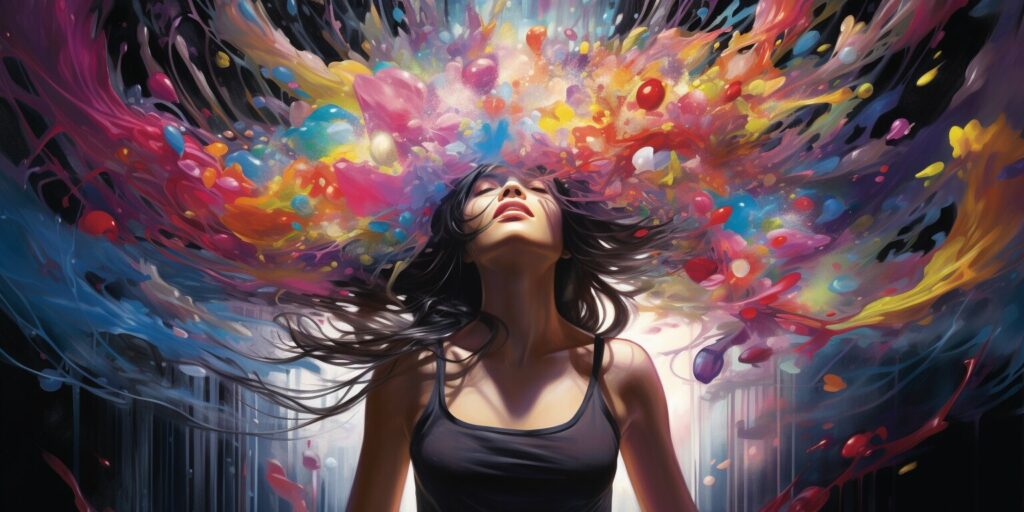Ever wondered why some people claim to hear colors or taste shapes? This phenomenon isn’t a figment of their imagination, but rather an intriguing condition known as synesthesia. For those who experience it, sensory pathways intertwine in unusual ways, leading to a unique perception of the world around them. I’m here to shed light on this fascinating subject and help you understand how synesthesia tests work.
Synesthesia is more than just a curious quirk—it’s a neurological trait that affects roughly 1 in 2,000 people. Some synesthetes might see letters as colored (grapheme-color synesthesia), while others could perceive music or sounds as vibrant hues (chromesthesia). The variations are endless. To identify if someone has this trait, we utilize what’s called a ‘synesthesia test’.
A synesthesia test doesn’t involve any invasive procedures; it’s based primarily on self-reporting and consistency over time. In fact, it can be quite an interesting exploration into one’s personal sensory experiences! But first things first: let’s delve into what these tests entail and why they’re so crucial for understanding this remarkable sensory condition.
Understanding Synesthesia: An Overview
Synesthesia, it’s a fascinating phenomenon. Let me break it down for you. It’s a condition where one sense (like hearing) is simultaneously perceived by one or more additional senses (such as taste). Imagine hearing a C-sharp note on a piano and immediately tasting vanilla ice cream, or seeing the number 7 as always brilliantly red. That’s what life can be like for someone with synesthesia.
To get our heads around this concept, let’s look at some facts:
- Approximately 1 in 2,000 people are synesthetes.
- There are over 80 known types of synesthesia.
- Synesthesia can develop in childhood or may be present from birth.
- Women are three times more likely to have synesthesia than men.
Now, don’t you find that intriguing?
The science behind this is equally riveting. Researchers believe that these experiences result from an increased cross-talk between different regions of the brain that are normally separate. However, the precise cause remains unknown – adding another layer of mystery to this peculiar sensory experience.
Though often viewed as unusual, many synesthetes wouldn’t want to part with their extra sensations. They often describe their experiences as a bonus sense – an added dimension that brings vibrancy and depth to everyday life.
If you’re wondering whether there’s any way to know if someone has synesthesia – yes there is! In fact, various diagnostic tests exist which help identify the presence of this condition.
In all its bewilderment and curiosity-provoking nature, understanding synesthesia truly compels us towards appreciating human perception in its most unique forms. After all, it’s not every day we come across individuals who can taste sounds or see numbers in color!
Identifying Common Types of Synesthesia
I’ve always been fascinated by the unique neurological phenomenon known as synesthesia. It’s a condition that, remarkably, allows some people to experience one sense through the stimuli of another. For instance, they might see colors while listening to music or taste flavors when reading words. There are several different types of synesthesia and I’m eager to delve into some of the most commonly identified ones.
First up on our list is Grapheme-Color Synesthesia. This type is probably what you think about when you hear ‘synesthesia’. People with this form have a distinct color associated with each letter or number. So for them, ‘A’ may always be red and ‘2’ could be green.
Then there’s Chromesthesia, another common form where sounds trigger visual experiences. A person with chromesthesia might see colors or shapes when they hear music, voices or other sounds. Imagine watching a private light show every time your favorite song comes on!
Next in line is Lexical-Gustatory Synesthesia – quite a mouthful isn’t it? In this unusual variant, certain words provoke tastes in the person’s mouth. It means someone could literally find your name sweet or sour – talk about tasting words!
We also encounter Ordinal Linguistic Personification where numbers, days and months possess personalities. Does Monday seem like an uptight individual while Saturday feels more laid back? You might just have this type of synesthesia!
Lastly let’s discuss Mirror-Touch Synesthesia – those who have it can feel the same sensation that another person feels just by observing them! Say your friend stubs their toe; if you wince feeling their pain – it’s not merely empathy at play here.
Synesthetic experiences vary greatly among individuals – no two synesthetes perceive the world in exactly the same way! Isn’t that something extraordinary? The realm of human perception seems limitless indeed.
The Science Behind Synesthesia: What Research Says
Diving into the marvel of synesthesia, it’s intriguing to highlight what science has uncovered about this fascinating phenomenon. Once dismissed as mere fantasy, synesthesia is now a respected subject in neuroscience. It’s essentially a perceptual condition where one sense (like hearing) gets mixed up with another (such as sight). This cross-wiring leads to experiences like seeing sounds or tasting colors.
Research reveals that synesthetes, people with synesthesia, possess more densely connected brains than their non-synesthetic counterparts. A study published in “Nature Neuroscience” found that the brain regions responsible for processing color and numbers are more interconnected in those gifted with grapheme-color synesthesia.
Here’s what the research data looks like:
| Study | Journal | Finding |
|---|---|---|
| 1 | Nature Neuroscience | Increased connectivity between color and number processing regions |
Moreover, functional MRI studies have unveiled increased activity in specific brain areas when synesthetes experience sensory overlap. For instance, during sound-to-color conversion, there’s heightened activity in the V4 region of the visual cortex which is responsible for color perception.
There’s also an interesting genetic angle to this story. While there isn’t a specific ‘synesthesia gene’, evidence suggests its hereditary nature since it tends to run in families. However, scientists are still trying to fully comprehend this genetic puzzle.
So why does all of this matter? Well, understanding how our sensory systems interconnect may shed light on neural plasticity – the brain’s ability to adapt and change over time. Furthermore, studying synesthesia could help us understand other complex conditions like autism or schizophrenia where sensory integration is often disrupted.
How to Recognize Signs of Synesthesia
Let’s dive straight into the signs of synesthesia. As a multisensory condition, synesthesia can manifest in myriad ways. However, there are some common patterns you might spot.
One classic sign is experiencing sensory responses that seem ‘cross-wired.’ For example, seeing specific colors when hearing certain sounds or associating numbers with distinct tastes. It’s not your average sensory experience, and it stands out.
Another telltale indicator is consistency over time. If Monday consistently appears as pale blue in your mind’s eye or the numeral ‘2’ always tastes like mint – you could be a synesthete! This isn’t an occasional glitch; it’s a persistent feature of your perception.
It’s also important to note that this isn’t about metaphorical thinking or creative imagination – synesthetes don’t just think about these associations; they literally perceive them. But remember, only a test conducted by an expert can confirm if you have synesthesia.
Here are few pointers to recognize signs:
- Sensory experiences that seem cross-wired (i.e., seeing sounds, tasting numbers)
- Consistent associations between unrelated categories over time
- Literal perceptions rather than metaphorical or imaginative connections
While fascinating and relatively harmless, living with undiagnosed synesthesia can be confusing and isolating for some individuals. Hence recognizing these signs becomes crucial.
Remember: understanding our unique neural wiring helps us navigate our world more effectively and empathetically! So let’s continue exploring the intriguing enigma that is synesthesia together!
Detailed Explanation of a Synesthesia Test
I’m sure you’re wondering, what exactly is a synesthesia test? Well, it’s an examination used to identify if someone possesses the unique trait known as synesthesia. This condition links one sensory or cognitive pathway to another. For instance, some people see colors when they hear music; others taste words.
The main purpose of a synesthesia test is to validate these uncommon sensory experiences. One common method is the “test of genuineness.” Here’s how it works:
- The person under testing describes their color-word associations (or other types of associations depending on their type of synesthesia) on multiple occasions.
- These descriptions are then compared for consistency.
- If there’s significant match across sessions, it suggests that the individual possesses this fascinating trait.
Another popular test is the “Stroop test”. In this assessment:
- Individuals are presented with colored words that either match or conflict with their reported color-word associations.
- Reaction times and accuracy rates during this task reveal whether there’s an automatic and involuntary nature to these perceptions.
It’s important to remember that these tests must be administered by trained professionals. Synesthesia isn’t something easily self-diagnosed since our brains can often trick us into believing things that aren’t actually true.
So far, research has shown that approximately 1 in 2,000 people have some form of synesthesia. While it may sound like a small number, consider this: in New York City alone, that would mean there are roughly 4,000 individuals experiencing life through an entirely different lens!
Synesthetes (people with synesthesia) don’t view their condition as debilitating. Instead, many see it as simply a different way of experiencing the world around them – adding more depth and vibrancy to everyday life! This is why understanding and identifying synesthesia through appropriate testing methods can be so enlightening.
Conducting a Self-Assessment for Synesthesia
Have you ever wondered if you might be one of the fascinating few who experience synesthesia? It’s a unique neurological condition where senses intertwine—imagine seeing sounds or tasting colors. Let’s dive into how you can conduct a self-assessment to figure this out.
First things first, understanding synesthesia is crucial. This isn’t your typical sensory experience—it’s far more vivid and intertwined. People with synesthesia might see numbers as inherently colored or associate specific tastes with distinct shapes. You’re not looking for metaphorical associations, like “sharp cheese,” but literal sensory overlaps that are consistent over time.
So, how do we uncover these hidden sensory links? One common method is using online tests developed by researchers studying synesthesia. These tests ask questions about your sensory experiences and look for patterns indicative of synesthetic perceptions.
Here’s what some common tests involve:
- The ‘Stroop Test’: This measures whether color-word association affects your ability to name the color of ink different words are written in.
- The ‘Grapheme-Color Test’: Here, you’ll be asked to assign colors to letters or numbers multiple times over several weeks—if your associations remain consistent, it may indicate grapheme-color synesthesia.
- The ‘Sound-Color Test’: In this one, various sounds trigger visualizations of colors—if these remain constant over time, it could suggest sound-color synesthesia.
All said and done, it’s important to remember that while self-assessments can provide interesting insights, they aren’t definitive diagnoses. If after taking these tests you suspect that you may have synesthesia, consider reaching out to a professional neuropsychologist for further evaluation and guidance!
In the world of neurodiversity and brain science there’s always more than meets the eye—or any other sense for that matter! Whether or not our journey here has led you to suspect a synesthetic brain wiring, I hope it’s sparked a fascination for the mind-bending ways our brains can process the world around us.
Implications and Benefits of Detecting Synesthesia Early
I’ve often been asked, “what’s the big deal about catching synesthesia early?” I’ll tell you, it’s a game-changer. Discovering synesthesia in its budding stages opens up a whole new world for those who experience it. It provides them with an understanding of why their perception differs from others’, fostering self-awareness and acceptance.
An early diagnosis can turn what might have been viewed as a problem into an opportunity. Some studies suggest that individuals with synesthesia tend to be more creative and artistic due to their unique sensory experiences. For instance, they might see colors when hearing music or taste shapes, which could be channeled into producing remarkable artwork or composing extraordinary music.
Let’s delve into some numbers here:
| Percentage | Synesthetes |
|---|---|
| 25% | More likely to choose art as a career |
In addition, identifying this condition early on allows for appropriate support systems to be put in place at school or home. This can lead to improved academic performance and overall mental well-being by reducing feelings of being misunderstood or ostracized.
Moreover, there are potential scientific implications too. The study of synesthesia aids researchers in exploring neural connectivity and sensory processing in our brains – pushing the boundaries of neuroscience further than we’d thought possible!
Above all else though, let’s remember that detecting synesthesia early equips individuals with information about themselves that could positively shape their lives. Understanding rather than confusion? Now that’s something we can all get behind!
Conclusion: Embracing the World Through a Synesthete’s Lens
As I pull together the threads of this article, it’s clear that synesthesia isn’t just an anomaly. It is, in essence, a unique sensory experience that opens up a world of vibrant colors, distinct tastes and unique sounds for those who live with it.
Synesthesia tests have become handy tools in diagnosing this condition. They’re not just helpful to researchers seeking to understand the phenomenon better but also empower individuals to make sense of their vivid and unusual experiences.
Taking on the world through a synesthete’s lens might seem overwhelming at first glance. Yet it’s as fascinating as it is complex. Here are some key takeaways from our discussion:
- Synesthesia varies greatly among individuals. Some may see letters or numbers as colors while others might taste sounds.
- The cause of synesthesia remains unknown but there is strong evidence suggesting genetic factors play a major role.
- Tests like “The Synesthesia Battery” can help identify this condition though they are not definitive proof.
Living with synesthesia isn’t merely about managing an excess of sensory information. On the contrary, many synesthetes consider their condition to be more like a gift rather than an impairment. It offers them unparalleled access to experiences most people could only dream of.
Ultimately, understanding and embracing synesthesia enriches our perspectives on human perception itself — reminding us all that there’s more than one way to perceive the world around us.



